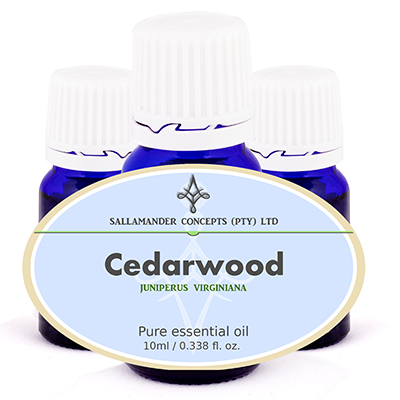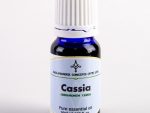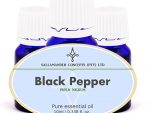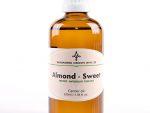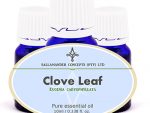Cedarwood essential oil information
Cedarwood essential oil is extracted from Juniperus virginiana of the Cupressaceae family. It is also known as Virginian, red, eastern red or southern red cedar, as well as Bedford cedarwood.
Cedarwood essential oil properties
Cedarwood essential oil has a soft, woody and “pencil-like” smell and has a faint undertone of sandalwood. It is pale yellow to light orange in color and is viscous.
Origin of Cedarwood
The tree is native to North America and grows up to 12 meters (40 feet) and ages up to 300 years. It is found in the Eastern and Central United States.
Cedrus libani or Lebanon cedar, from which the first essential oil of this tree was extracted, is very scarce due to over use. This is the tree Solomon used to build the Temple in Jerusalem.
Extraction of Cedarwood essential oil
Wood chips and sawdust are subjected to steam distillation to extract the oil and the yield is about 35 %.
Chemical composition of Cedarwood essential oil
α-Cedrene, Thujopsene, Cedrol, β-Cedrene, α-Selinine, Widdrol, β-Himachalene, β-Chanigrene, α-Chamigrene, Cuparene
Suggested precautions for Cedarwood essential oil
Cedarwood essential oil is found to be non-sensitizing and relatively safe for use on the skin. A few studies suggest an unfavourable reaction to high dilution rates of this oil when applied to the skin – specifically amongst people with known sensitivity to fragrances.
Please read our page with heading: Safety with Essential Oils before using this oil.
We recommend the following book as an excellent resource regarding safety:
Essential Oil Safety: A Guide for Health Care Professionals by Robert Tisserand & Rodney Young (#ad)
Therapeutic properties of Cedarwood essential oil
The therapeutic properties of cedarwood oil are antiseborrhoeic, antiseptic, antispasmodic, tonic, astringent, diuretic, emmenagogue, expectorant, insecticide, sedative and fungicide
Uses of Cedarwood essential oil
Cedarwood essential oil’s great benefit lies in its ability to calm and sooth nerves. It relieves skin and hair problems and is important in easing conditions of a respiratory nature. It also clears urinary infections, rheumatism and arthritis.
On the skin
Cedarwood essential is said to have a sedative effect on the skin and to relieve itching.
Its astringent action is great for acne, oily skin, as well as for hair and dandruff. It helps with chest and urinary infections, acts as a general tonic and has a pronounced effect on mucus membranes.
It has a calming and soothing effect on the mind and is of great help in conditions associated with anxiety and nervous tension. It is also of value in cases of arthritis and rheumatism.
Cedarwood can be used in a blended massage oil, or diluted in the bath to assist with asthma, bronchitis, respiratory problems, catarrh, cystitis, painful joints, oily skin and dandruff. Care must be taken that it does not cause irritation to the mucus membranes.
When diluted in a cream or a gel, cedarwood oil is of great value to combat oily skin and related problems, as well as dermatitis and psoriasis, while bringing relief to the scalp from dandruff.
Burners and Vaporizers
In vapor therapy, cedarwood oil can be used for arthritis, bronchitis, rheumatism, respiratory problems, as a general tonic and as an insect repellant.
Suggested dilution rates
On the skin
Adult:
Face: 0.5% to 1.5%
Body: 1.5% to 3%
Bath: 1.5% to 5%
3 to 24 months:
Face: 0.1% to 0.25%
Body: 0.25% to 0.5%
Bath: 0.25% to 0.5%
2 to 6 years:
Face: 0.25% to 1.5%
Body: 0.25% to 2%
Bath: 0.25% to 2%
6 to 15 years
Face: 0.5% to 1.5%
Body: 1.2% to 3%
Bath: 1.2% to 3%
Pregnancy
Face: 0.5% to 1.5%
Body: 0.5% to 2%
Bath: 0.5% to 2%
- When in doubt consult your doctor / medical professional before use.
- Most professionals and/or Aromatherapists will always err on the side of safety when giving advice regarding the use of essential oils and oleo resins during pregnancy.
- Quite a number of Aromatherapists advise that you should avoid essential oils completely while pregnant, specifically during the first trimester. This is a very safe approach but may not be necessary at all.
Burners and Vaporizers
Use 2 to 8 drops
General:
- When using for the first time – Always use the lowest dilution rate and build up slowly to the maximum. Stop using all essential oils on the skin if irritation or allergy occurs.
- Any advice or instruction received from a medical professional ALWAYS supersedes recommendations or advice found on this website. When in doubt consult your doctor / medical professional.
Summary
Cedarwood Essential Oil, a clean smelling, balsamic oil helps calm and balance energy and promotes spirituality, while helping to clear the respiratory system of excess phlegm and catarrh.
It helps sort out urinary tract infections, as well as bladder and kidney disorders, while improving oily skin and clearing up dandruff.
The Egyptians used the oil in the mummification process, in cosmetics and as an insect repellent, while native Americans used Cedar oil in medicine and burn it for purification.
These days the wood is often used in the making of pencils and boxes.
Cedarwood essential oil blends well with
Cedarwood essential oil blends well with Benzoin, Bergamot, Cinnamon, Cypress, Frankincense, Jasmine, Juniper berry, Lavender, Lemon, Neroli, Rose and Rosemary.

